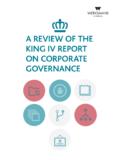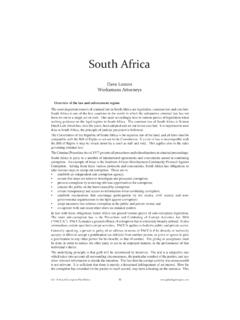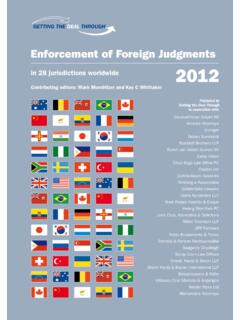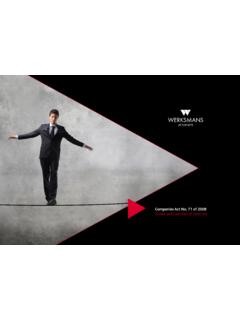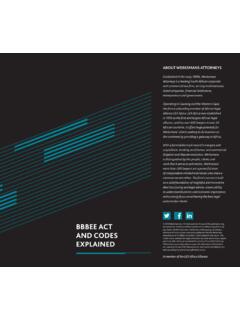Transcription of BASICS OF BUSINESS RESCUE - Werksmans
1 2 BASICS OF BUSINESS RESCUE3 1 Restructuring of companies in financial distress is on the increase globally. In line with this trend, chapter 6 of the new Companies Act, No. 71 of 2008 (the Act) introduces BUSINESS RESCUE to the South African BUSINESS African companies that are financially distressed in South Africa now have an opportunity to reorganise and restructure. This has far reaching effects on creditors, financial institutions, shareholders, employees and restructuring document highlights some of the Frequently Asked Questions around BUSINESS 1. What is BUSINESS RESCUE ? BUSINESS RESCUE proceedings are proceedings aimed to facilitate the rehabilitation of a company that is financially distressed by providing for the temporary supervision of the company, and the management of its affairs, BUSINESS and property, by a BUSINESS RESCUE practitioner; a temporary moratorium (stay) on the rights of claimants against the company or in respect of property in its possession; and the development and implementation, if approved, of a BUSINESS RESCUE plan to RESCUE the company by restructuring its BUSINESS , property, debt, affairs, other liabilities and equity (section 128(1)(b)).
2 2. What is the aim of BUSINESS RESCUE ?The aim of BUSINESS RESCUE is to restructure the affairs of a company in such a way that either maximises the likelihood of the company continuing in existence on a solvent basis or results in a better return for the creditors of the company than would ordinarily result from the liquidation of the company (section 128(1)(b)(iii)). 3. What is a BUSINESS RESCUE practitioner?A BUSINESS RESCUE practitioner is a person appointed, or two or more persons jointly appointed, to oversee a company during BUSINESS RESCUE . While the Act defines a BUSINESS RESCUE practitioner as one or more persons, the BUSINESS RESCUE provisions of the Act do not necessarily refer to or support joint appointment. Further, the word person in the Act includes a juristic person. It is therefore arguable that a company can take appointment as a BUSINESS rescues practitioner (section 128(1)(d)).
3 4. What is an affected person?Affected persons are important role players in the BUSINESS RESCUE process. An affected person is a shareholder, creditor, employee (or their representative) or a registered trade union representing employees of the company. Affected persons have various rights throughout the BUSINESS RESCUE process (section 128(1)(a)).5. What is the test for BUSINESS RESCUE ?The test for whether or not a company should be placed in BUSINESS RESCUE is whether or not the company is financially distressed. The Act defines the words financially distressed (section 128(1)(f)) to mean that it appears to be reasonably unlikely that the company will be able to pay all of its debts as they become due and payable within the immediately ensuing six months (commercial insolvency); or it appears to be reasonably likely that the company will become insolvent within the immediately ensuing six months (factual insolvency).
4 3 BUSINESS RESCUE PROCEEDINGS4 1. When should a company commence BUSINESS RESCUE ?A company should commence BUSINESS RESCUE proceedings at the first signs of it being financially distressed, within the meaning of the Act. That is, either when it is reasonably unlikely that a company will be able to pay its debts when they fall due for payment in the immediately ensuing six months or when it is likely that the company will become insolvent in the immediately ensuing six months. In a recent decision of the South Gauteng High Court, in the case of Welman v Marcelle Props 193 CC JDR 0408 (GST), the court stated that BUSINESS RESCUE proceedings are not for terminally ill close corporations. Nor are they for chronically ill. They are for ailing corporations, which given time will be rescued and become solvent . This statement supports the contention that at the first signs of financial distress, a company should apply for BUSINESS RESCUE .
5 Once a company is more than financially distressed , options other than BUSINESS RESCUE become more attractive for ailing companies, such as liquidations or compromises. 2. How is a company placed in BUSINESS RESCUE ?There are two main ways in which a company can be placed in BUSINESS RESCUE , namely when the board of directors of a company resolves that the company voluntarily commence BUSINESS RESCUE proceedings and be placed under the supervision of a BUSINESS RESCUE practitioner (section 129 of the Act); and when an affected person makes a formal application to court for an order placing the company under supervision and commencing BUSINESS RESCUE proceedings (section 131 of the Act), provided the company has not already been placed under BUSINESS RESCUE in terms of section 129, on the basis that the company is financially distressed; the company has failed to pay over any amount in terms of an obligation under or in terms of a public regulation, or contract, with respect to employment related matters.
6 Or it is otherwise just an equitable to do so for financial reasons, and there is a reasonable prospect of rescuing the How does a company practically voluntarily commence BUSINESS RESCUE proceedings?The company must file Form with the Companies and Intellectual Property Commission ( CIPC ) and this must be accompanied by the resolution of the board of directors of the company (in which it resolves to commence BUSINESS RESCUE proceedings, and if it has a BUSINESS RESCUE practitioner in mind at the time, to appoint a certain person as the A company should commence BUSINESS RESCUE proceedings at the first signs of it being financially distressed, within the meaning of the Act. 5practitioner) together with a statement setting out the facts upon which the resolution was founded. Thereafter, the company must comply with a number of notice and publication requirements prescribed by the What preliminary actions are required of a company that commences voluntary BUSINESS RESCUE ?
7 In terms of section 129(3) & (4), once a company has commenced BUSINESS RESCUE proceedings, pursuant to the passing of a board resolution in terms of section 129, the company must within five BUSINESS days of filing the Form , resolution and statement, with CIPC, publish notice of the resolution, together with a sworn statement as to the reasons why the company is financially distressed, detailing the prospects of rescuing the company, to all affected persons; and appoint a BUSINESS RESCUE practitioner; after appointing a BUSINESS RESCUE practitioner, file a notice of the appointment of the BUSINESS RESCUE practitioner within two BUSINESS days with CIPC; and publish a notice of the appointment of the BUSINESS RESCUE practitioner within five BUSINESS days after the notice is What happens if the time periods in respect of voluntary BUSINESS rescues are not adhered to?
8 With regard to voluntary BUSINESS rescues, in terms of section 129(5)(a), if a company fails to comply with the provisions of sections 129(3) and (4), the resolution lapses and is a nullity and the company may not file a further resolution for a period of three months after the date on which the resolution was adopted, unless a court, on good cause shown, approves of the company filing a further resolution (section 129(5)(b). Further, an affected person can make application to court in terms of section 130(1)(a)(iii) to set aside the resolution on the grounds that the company has failed to satisfy the procedural requirements set out in section 129. 6. How can one object or oppose a BUSINESS RESCUE resolution?Section 130 provides that at anytime after the adoption of a BUSINESS RESCUE resolution, an affected person may apply to court for an order setting aside the resolution on the grounds that (i) there is no reasonable basis for believing that the company is financially distressed; (ii) there is no reasonable prospect for rescuing the company; or (iii) the company has failed to satisfy the procedural requirements in section 129; setting aside the appointment of the practitioner on the grounds that the practitioner (i) does not satisfy the requirements of section 138; (ii) is not independent of the company or its management; or (iii) lacks the necessary skills, having regard to the company s circumstances.)
9 Or requiring the practitioner to provide security (in an amount and on terms and conditions that the court considers necessary to secure the interests of the company and any affected person).A director of a company that votes in favour of a resolution may not apply to court to set aside the resolution or the appointment of the BUSINESS RESCUE practitioner unless such person can satisfy the court that he acted in good faith on the basis of information that has since been found to be false or misleading (section 130(2)).Each affected person has a right to participate in a hearing contemplated by this section (section 130(47)).7. What goes into the papers for an application to court for BUSINESS RESCUE ?The decision of the Western Cape High Court, Cape Town, in the case of Southern Palace Investments 265 (Pty) Ltd v Midnight Storm Investments 386 Ltd 2012 (2) SA423 (WCC) was instructive about the nature of the evidence that must be placed before a court in order to 6 ensure that an applicant indicates that there is a reasonable prospect that the company can be rescued and to ensure that an application for BUSINESS RESCUE is successful.
10 Judge Eloff dismissed the application for BUSINESS RESCUE . He held that ..it is difficult to conceive of a RESCUE plan that will have a reasonable prospect of success of the company concerned continuing on a solvent basis unless it addresses the cause of the demise or failure of the company s BUSINESS , and offers a remedy therefor that has a reasonable prospect of being sustainable. A BUSINESS plan which is unlikely to achieve anything more than to prolong the by substituting one debtor for another without there being light at the end of a not too lengthy tunnel, is unlikely to suffice . The court went on to state that the applicant must deal with concrete and objectively ascertainable details in support of BUSINESS RESCUE and which facts are beyond mere speculation . These facts should include - the likely costs of rendering the company able to commence with its intended BUSINESS or to resume the conduct of its core BUSINESS ; the availability of cash resources to enable the company to meet its daily expenses and the nature of the funding on which the company will rely; the availability of any other necessary resources, such as raw materials and human capital ; and the reasons why the proposed BUSINESS RESCUE plan will have a reasonable prospect of success.
